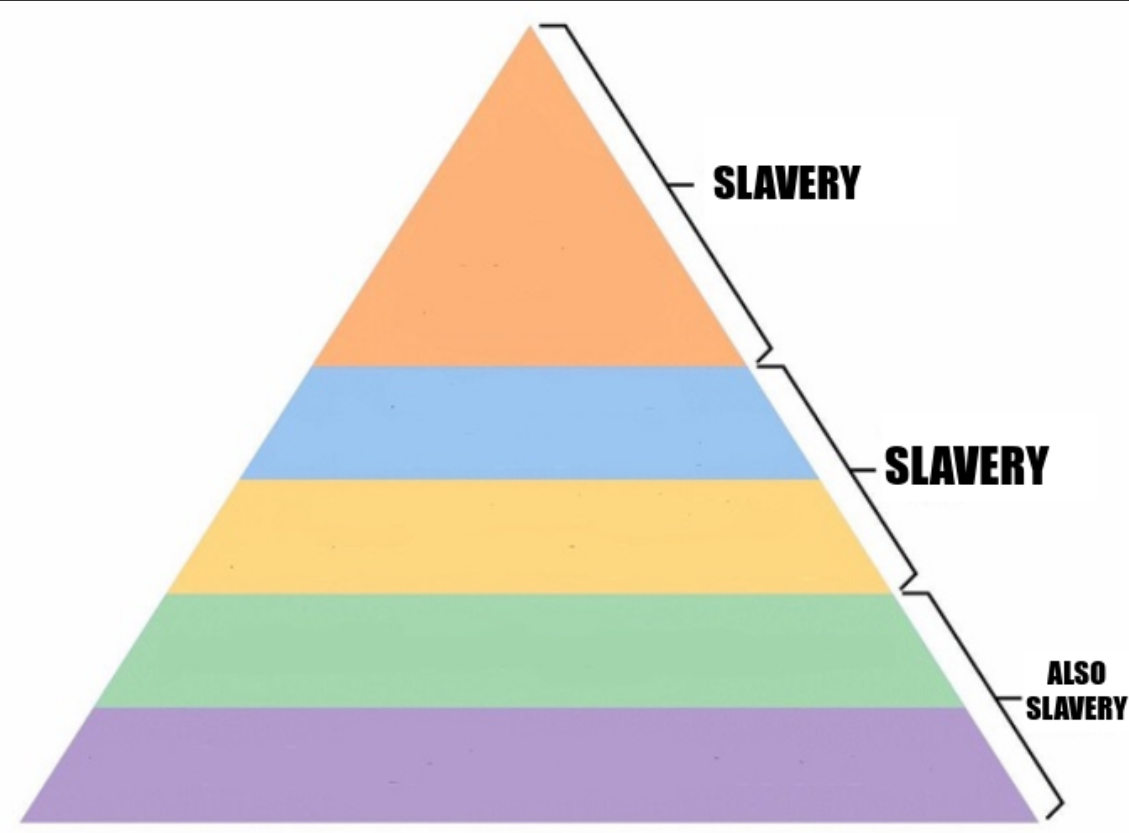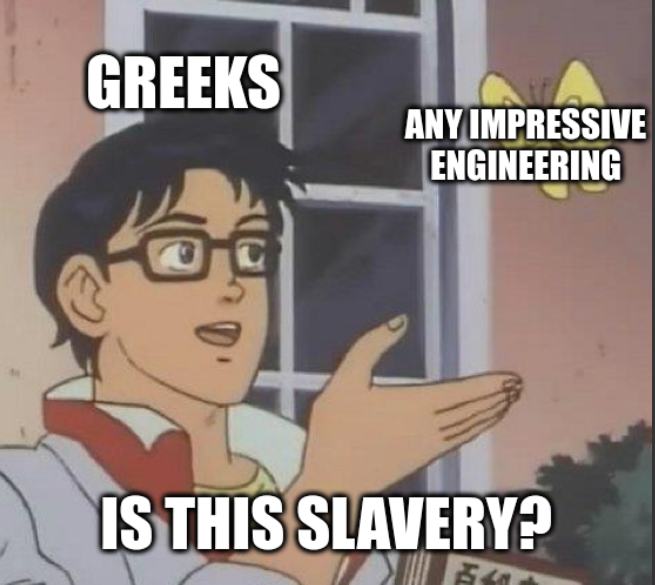Any idiot can build a bridge that stands. It takes an engineer to design a bridge that barely stands.
Tbh, I want my memes with sources. and this one is strange…
https://civilizationchronicles.com/roman-engineering-and-mathematics/ claims that mathmatics were essensial to roman engineering.
whereas this (only abstract avaliable…) https://link.springer.com/chapter/10.1007/978-3-662-66494-0_25 claim that mathmatics were but an auxillary science? 🤔
nontheless mathmatics seems to have been quite understood and used by the roman engineers building among other things, aqueducts
The joke is that calculus as a field of mathematics didn’t exist until millennia after the fall of the empire
Astrology was so important to the Greeks, they figured out the elliptical orbits of the planets (up to Jupiter) and how to compute them without calculus.
Right, I’m not denying that. People have always been smart. The problem that calculus solved was the intensely difficult algebra that it replaced
ironically, algebraists are currently trying to replace calculus with more algebra. needless to say, the algebra involved is pretty extreme
Calculus is a specific field of mathematics, mostly to do with limits, integrals and derivatives. Those all feature very heavily in working out loads and stresses.
But it’s unfair to say the Roman didn’t have calculus. It wasn’t formal calculus, but they absolutely had mathematics, and the Greeks worked out the exhaustion method a century before the Via Appia was even started.
You don’t need calculus to do some very impressive building, you can go very very far with experience, rules of thumb and basic maths. Hell, ask any civil engineer and they’ll gladly show you some common formula that makes physicists cry.
Put simply, you don’t need to know of, or what a certain field of math is to be able to apply the different fundamentals of it.
As an example. You ever see a basketball player bring out a chalkboard to calculate the trajectory, mass, spin, or force to throw the ball to get it in the basket? No. Over time they all eventually create a physics model in their heads and are able to subconsciously calculate all of that with relative accuracy based on experience, training, and practice. Yet, a lot of those players never took a lick of physics.
Do you happen to know any civil engineers, I would like to see these formulas
Hi, civil engineer* here. Nah, fam: a lot of the time we don’t even use formulas; we just look shit up in tables or interpolate on a graph!
(* To be fair, (a) I specialized in traffic, and (b) I didn’t do all that much professional work as a civil engineer before switching to software “engineering” instead. That’s even less mathematically rigorous most of the time, LOL.)
One of the famous ones is laminar flow in a tube or pipe. There’s a very nice physics formula to compute Reynolds number, and when it’s over 3500, flow is usually turbulent, and below 2000 it’s usually laminar. And anywhere in between? Eh, it kinda depends. Unless there are bends in the tube, then it depends even more. Oh, and when your flow is not in a tube, the values wildly vary even more.
There’s a concept of “angle of repose”, basically at what slope will loosely poured materials sit. There are super complex modern models to compute that, based on grain size and shape. But there’s also a half-page table listing anything from asphalt to coffee beans, which is literally the law in a lot of countries. That table is older than the age of sail in most cases and zero maths went into it.
And then there is the hilarious official ways to determine the characteristics of concrete and asphalt. The flow test, for example includes the highly scientific steps of “pour into a specific cone and poke 25 times with a two by four, then measure the circle on the floor”. This number is then used in several calculations.
π=3
Ohh yeah, I’ve used that one
You from Indiana too? Lol
Not civil but mechanical engineer here. There are some rule of thumb formulas involved during the construction of a gearbox, e.g. the diameter in
mmof a shaft at the bearings: cubic root of the torque inNm. The ‘necessary volume’ of a gear wheel is another formula involving adventurous math.when we approximate g to 10 they weep.
Calculus was invented in the late 1600s, almost 2000 years after the Roman aqueducts were built. The Roman engineer would know some geometry, but certainly not calculus.
That calculus as a modern field wasn’t established until the 1600’s does not mean the Romans only had geometry. That’s not how technology works. It doesn’t fit neatly into containers defined by modern thought. They likely developed what they needed and thought nothing of calling it something else because their purpose for it was different. For example Calculus is often called the study of change, not something the Romans were super interested in. Unlike the Greeks who were figuring out astronomy math. If you want to see how far they were before things started falling apart you’d have to get a historian to tell you what they even considered the mathematical fields to be and look at how they used it.
The engineer guy on YouTube did an episode the engineering method explaining how ancient and medieval Masons built stuff without math. https://youtu.be/_ivqWN4L3zU?si=2N_iyZiBD8eDpltR
Though I am sure the Romans used plenty of math during the construction of many of their projects.
and medieval Masons built stuff without math. https://youtu.be/_ivqWN4L3zU?si=2N_iyZiBD8eDpltR
That video shows that all of those ancient engineers relied heavy on math. What do think math is, if not all of the engineering principles laid out in that video?
You know what I mean. Sorry my words weren’t good enough
The mathematics mentioned in the first source have nothing to do with engineering though.
Ratios, a little trigonometry and geometry, all of which are essentially under the geometry category and arithmetic are not what concerns the engineering field. They are architectural tools if you will. Of course they utilized geometry, that’s not something innovative. Maths in general does not mean anything here, maths can be about number theory(completely unrelated to any practical application).
What differentiates them and engineers now is essentially mechanics. Forces, torques, stresses, materials, masses, moments of inertias etc. They never applied quantitative engineering principles, their structures were only sound from experience and intuition, the geometry mentioned was for architectural purposes.
Romans had a basic understanding of proportions and general vibes of design, but they couldn’t really create calculations to verify their design as we do today. For instance, the designers of the Pantheon understood they needed to lighten the concrete as it went up and had novel techniques of doing so that we use today, but they didn’t really know.
The state of the art for understanding basic stresses didn’t become known until the 19th century. The design of the Eiffel Tower was impressive, in part, because that structure has a calc book defending it. A lot of early railroad bridges were still designed based on ratios and vibes.
That said, not all loads were understood by that time. The Tacoma-Narrows Bridge collapsed in part because of a gross misunderstanding of wind loads combined with the ability to design structures light enough that wind loads controlled.
Oh yeah. The chad slavedriver vs the virgin computer guy. Tale as old as time
Slavery is the most impressive form of engineering. Ever wonder how they built the pyramids?

I’m begging people to actually educate themselves on how the pyramids were built. They were built by paid workers, but then later, the Greeks saw them and assumed they were built by slaves because that’s what the Ancient Greek did with their building projects.
Oh you’re right. Did a quick google search and apparently the Greeks just thought up the slavery thing. Not sure why that narrative was still taught in school. Sequel meme

deleted by creator

Inside Ricks battery judging is easy.
Well tbf you could argue that having to earn money is forced labor, and therefore a form of slavery, as well. Just that you get to choose your (ab)user.
The claims that they were built by the slaves or voluntary labor are both wrong. They were built by levied labor. Think a military draft, but you’re performing general labor for the state instead of fighting. Yes, those on the work gangs were fed, housed, and paid while there. But they weren’t building pyramids of their own free will either. It was still conscripted and forced labor. After their term of service, the workers got to go home. But it was still forced labor.
That’s pretty much my understanding too, but I’d like to point out that conscripted labor is pretty analogous to a tax. My contemplation on the subject:
I think equitable taxes are good when the revenue is used for things that benefit society.
I don’t know how equitably the labour was conscripted.
I don’t think enormous pyramids are good for society, but on the other hand I don’t know how ancient Egyptian workers would have felt about the topic.
I suspect that the Pharoahs weren’t very concerned about how the workers felt about the topic.
And I’d like to point out that the “proof” that slaves weren’t used to build the pyramids is some laborer villages being found and gasp
They got to eat FOOD!
BUT WAIT, THERE’S MORE
Some of the people that died in accidents were buried on site! By people that thought you’d serve them in the afterlife too! What an honor!
So we know SOME laborers were paid! And they got to eat food! And serve eternally instead of having their bodies dismembered and fed to hogs! For some pyramids!
And a KNOWN slaver culture definitely wouldn’t have had some people working on it be slaves and some wouldn’t be! As any student of history knows, either everyone’s a slave or no one is!
Cue a thousand Redditor “UM AKSHUALLYS!”
Yeah, we know a lot about ancient Egypt, but there’s a lot we don’t know too.
Sauce?
Is it slave labour if they can choose to strike?
Yes, that’s called a slave revolt. In that specific case, a couple things of note:
1: You can have both slaves and “free” workers build the same thing.
2: Egypt almost certainly enslaved a large number of war captives from the Sea People invasion
3: That is literally five hundred years after the last pyramid. The Pharaohs moved on to building hidden tombs because it was both cheaper and less of a giant stone monument telling thieves were a rich guy buried some treasure.
Laughs in single thread solidworks. You want SW to preform? Over clock a dual core to 6ghz.
As a Network Engineer I only use Freecad.
✨𝓬𝓪𝓵𝓬𝓾𝓵𝓾𝓼✨
They actually released freeCad, I wonder if it’s any better
Common gromatici W












